Bulletin – December 2013 Global Economy Korea's Manufacturing Sector and Imports from Australia
- Download the article 421KB
Abstract
The Korean economy has grown rapidly over the past half century, driven in part by the development of an export-oriented manufacturing sector. While the electronics industry has expanded rapidly since the 1970s, there has also been a shift towards more steel-intensive industries, such as transport equipment and metal products. This shift, combined with Korea's reliance on resource imports, led Korea to become Australia's third largest export destination.
Introduction
The Korean economy has grown rapidly over the past half century, underpinned by the development of an export-oriented manufacturing sector. It is now the 12th largest economy in the world on a purchasing power parity (PPP) basis and the 8th biggest exporter of goods and services. The growth in the Korean economy, and the nature of that growth, has resulted in it becoming Australia's third largest export destination, with the share of Australian exports going to Korea rising to 7 per cent in 2012/13 (Graph 1). While this is a result of the Korean economy's strong growth over this period, it is also a consequence of the strong growth in resource-intensive manufacturing.
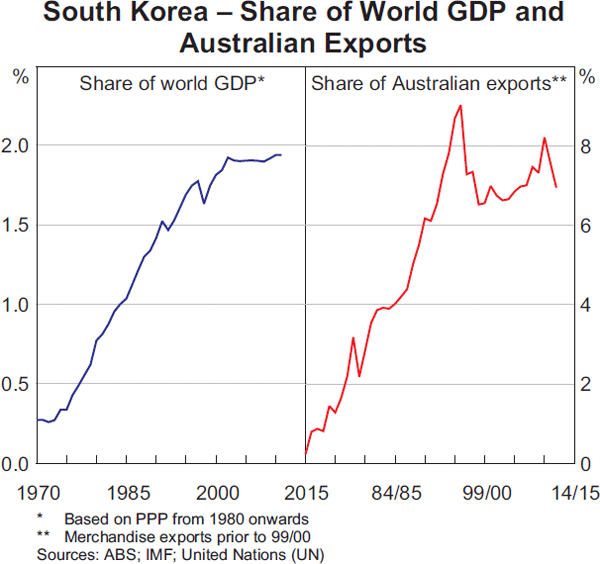
The structure of global manufacturing production has changed over the past few decades, particularly in east Asia and China. Processing trade, whereby the manufacture of components and assembly of the final goods take place in more than one country, has grown in importance (Craig, Elias and Noone 2011). The development of these supply networks has been associated with large flows of foreign direct investment into lower-income economies, which have become major destinations for the outsourcing of global manufacturing (Berger-Thomson and Doyle 2013). With this, manufacturing production has shifted from higher-income economies to lower-income economies.
The growth in this processing trade has meant that many economies have experienced faster growth in their imported inputs than their production. That is, the share of domestic content in manufactured goods has declined. While Korea has participated in the increased integration of global supply chains, in contrast to many other economies in the region it has also experienced an increase in the domestic content of production. This reflects a reduction in the economy's reliance on imported capital and intermediate goods, particularly steel products.
This article explores how the Korean economy has evolved over time and developed a steel-intensive manufacturing sector, which has resulted in a high share of Australian resource exports going to Korea.
Korea's Economic Development
Korea's economy has expanded rapidly over the past half century; since the early 1960s, Korea's real GDP has increased at an average annual rate of about 8 per cent and around 5½ per cent on a per capita basis, exceeding that of many neighbouring and advanced economies (Graph 2).[1]
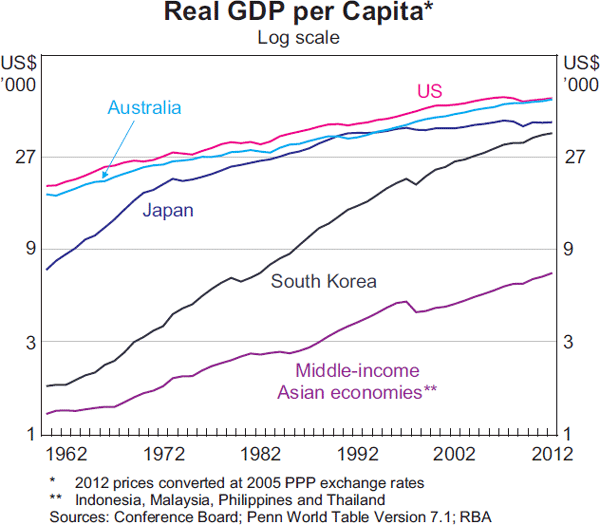
Korea's rapid economic growth has been underpinned by the development of a broad-based export-oriented manufacturing sector from a relatively low base. The share of manufacturing in the economy has increased over the past four decades. This stands in contrast to the experience of Japan and the United States, where the manufacturing share of the economy has declined steadily as manufacturing production has shifted to lower-income economies (Graph 3).
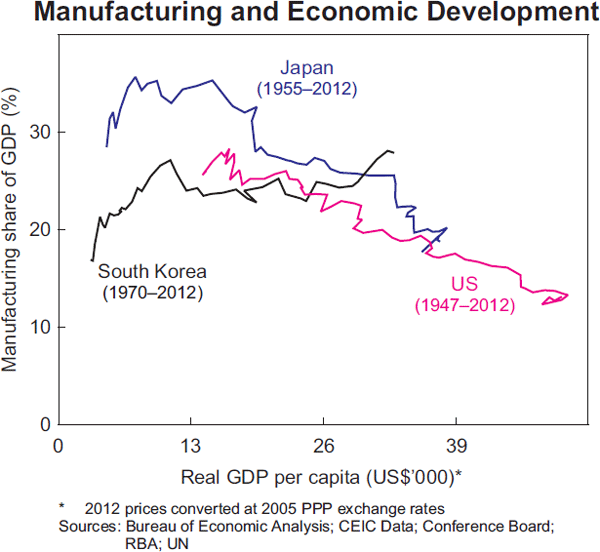
In Korea, the growth of manufacturing of transport equipment, machinery and metal products since 1970 has been driven by the output of a relatively small number of privately owned enterprises, known as ‘chaebol’.[2] However, during Korea's rapid development phase their access to finance was controlled by the Korean Government. Given the underdeveloped state of the Korean financial markets at that time, access to credit was vital for their expansion (Krueger and Yoo 2002). The government's industrial policies were directed to the development of the sectors of the economy perceived to have long-term potential, and so the chaebol focused on the automotive, shipbuilding and electronics industries, and reduced the economy's reliance on imported capital and intermediate goods (Amsden 2004). The share of the textiles & leather industry, which had dominated manufacturing in the 1970s, declined over the past four decades, in part reflecting lower wages in less developed economies that have attracted a larger share of the global textiles industry (Graph 4).
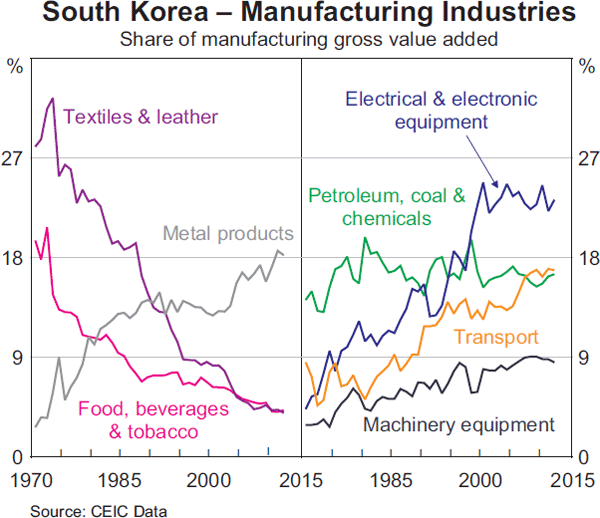
To promote export-led growth, some manufacturing industries were initially supported by export incentives, including reduced corporate and private income taxes, and tariff exemptions on raw materials imported for export production (Savada and Shaw 1990). With the rise in the importance of export-oriented industries over the past half century, the ratio of exports to GDP rose from 13 per cent in 1970 to almost 60 per cent in 2012.
Manufacturing in Korea
Currently, the main manufacturing industries in Korea are electrical & electronic equipment, metal products, chemicals, transport equipment and machinery. Australian resource exports are used intensively as inputs in industries manufacturing metal products, transport equipment and machinery – in particular, automobiles, shipbuilding and steel production. Although electrical & electronic equipment is Korea's largest manufacturing industry in terms of value added, it is less resource-intensive and therefore less important for Australian commodity exporters.
Automobile Industry
Korea's automobile industry is the fifth largest in the world, representing around 6 per cent of global production. The majority of vehicles produced in Korea are exported. The industry accounts for around one-tenth of Korea's manufacturing sector. Three big manufacturers, Hyundai, GM Korea (formerly Daewoo) and Kia, collectively account for roughly 90 per cent of automotive production (KAMA 2012). The industry has gone through a radical shift over the past five decades. In the early 1960s, there was no automobile parts industry in Korea, and production consisted of assembling automobile kits primarily imported from Japan and the United States. Over time, domestic machinery and automotive parts industries have emerged alongside automobile assembly, increasing the domestic value-added component of production. Domestic content in automobiles rose to around 60 per cent in 1972, and was over 90 per cent by the end of the 1970s (Greenbaum 2002). Today, the expansion down the automotive supply chain has continued to the stage where some Korean automakers import raw materials and transform them into automobile components that are either exported or assembled into finished vehicles in Korea (Graph 5).
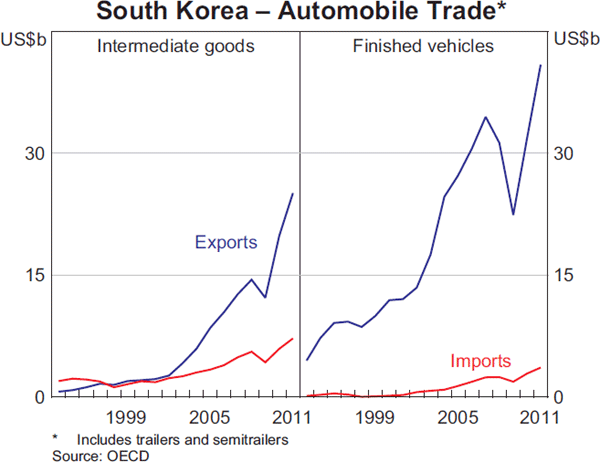
Shipbuilding
Korea's shipbuilding industry became the largest in the world in 2003, surpassing Japan. Korea's share of global shipbuilding has remained relatively stable since then, while the market share of former global shipbuilding leaders Japan and Europe has declined as China's share has recently caught up to that of Korea, which had previously been the world's largest shipbuilder (Graph 6). Since the global financial crisis, there has been a downturn in shipbuilding orders and prices. Competitive pressures remain strong as the industry faces significant overcapacity, which has caused prices to fall by around 50 per cent from their 2008 highs. The industry has also faced difficult funding conditions in recent years (BRS 2013).
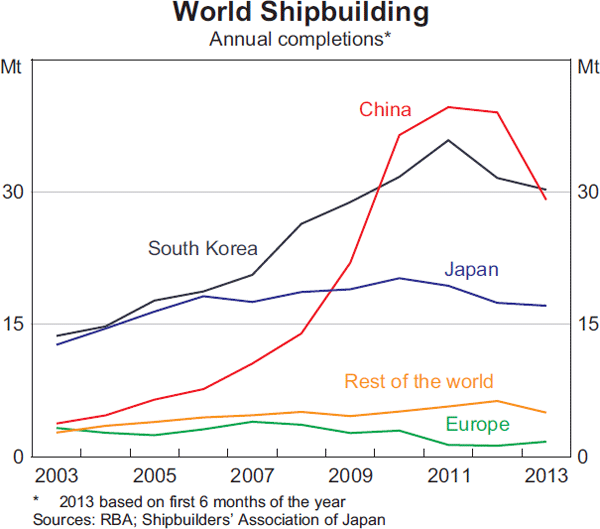
The Korean shipbuilding industry is highly concentrated, dominated by three large shipbuilders: Hyundai Heavy Industries (the world's largest shipbuilding company), Samsung Heavy Industries and Daewoo Shipbuilding & Marine Engineering (European Commission 2009). The increased competition from Chinese shipbuilders has pushed Korean production toward specialised higher value-added units, such as LNG tankers in which Korea holds an 85 per cent market share. As Korean shipbuilders have faced rising costs of production in Korea, some, such as STX and Samsung, have increased production of less-specialised carrier ships in China (BRS 2013).
Steelmaking
Korea has the highest production of steel, per capita, in the world (Graph 7). Korean steel production per capita has continued to increase throughout its development. Echoing the experience with manufacturing, the continued rise in steel use in Korea contrasts with the experience of the United States and Japan where steel production per capita peaked and then plateaued at an earlier stage of development.
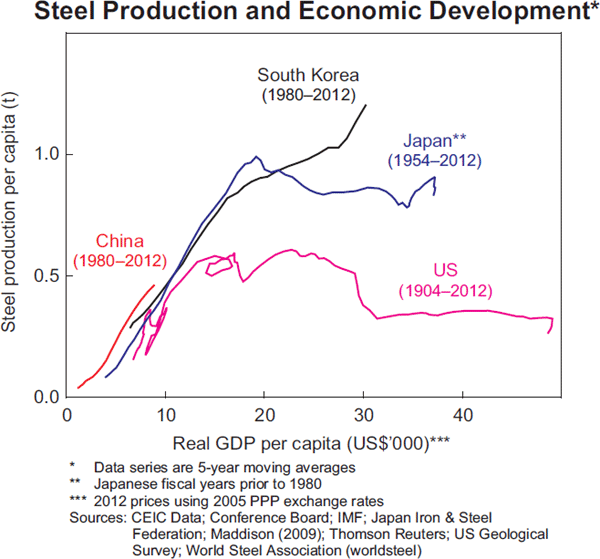
Korea's steel industry ranks as the sixth largest in the world, accounting for around 4½ per cent of global steel production in 2012. In part, this reflects the intensive use of steel in its manufacturing and export sectors. Importantly for Australia, the majority of Korean steel is produced in blast furnaces (over 60 per cent in 2012). Blast furnaces use iron ore and coking coal as direct inputs, while the alternative electric arc furnaces produce steel from scrap metal (Worldsteel Association 2013b).
The proportion of Korea's total steel demand accounted for by the manufacturing sector grew from 55 to 70 per cent between 2000 and 2009, while the proportion used in construction declined (Graph 8). These shifts in steel demand by industry reflect the steady decline of the construction sector as a share of the economy over the past 10 years, while automobile production and shipbuilding have grown. There was a marked decline in steel used by the automobile industry following a fall in production during the global financial crisis, but production has picked up since then (Haugh, Mourougane and Chatal 2010).
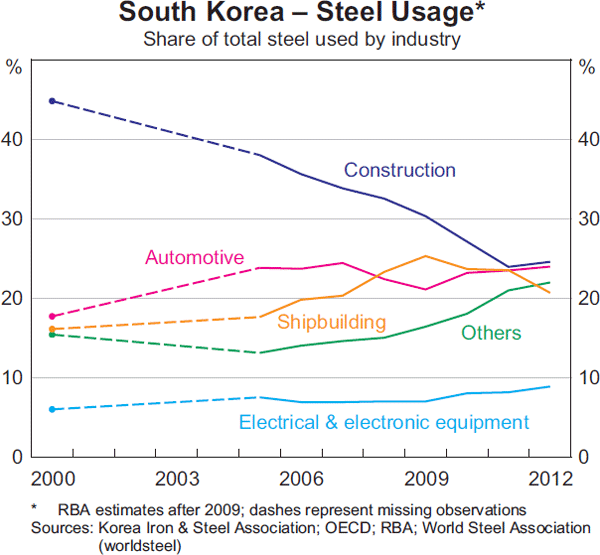
Korean steel production has grown rapidly since 2009, increasing twice as fast as both global and Chinese production. Recent growth in production has been largely the result of expansions in blast furnace production capacity, which has become relatively more important over time in Korea, while production in electric arc furnaces has remained little changed (Worldsteel Association 2013a). A recent example of the rise in production capacity is the construction of three blast furnaces with a combined annual capacity of 12 Mt at Dangjin steelworks by Hyundai Steel, Korea's second largest steelmaker after POSCO (Hyundai Steel 2012). Although the steelworks is primarily intended to supply Hyundai and Kia Motors, it also gives Hyundai Heavy Industries scope to increase domestically produced steel content in ships.
Korea is a major importer and exporter of steel in the global market. The significant growth of Korea's steel production capacity over the past couple of years means that Korea has moved from being a net importer of steel to a net exporter, with over half of these exports going to Asia (Graph 9; KOSA 2013). In 2012, Korea was the fifth largest net exporter of steel in the world. Around half of the steel used in Korean production is exported indirectly as a component of other traded goods shipped from Korea. In 2011, Korea was the third largest net indirect exporter of steel (Worldsteel Association 2013b).
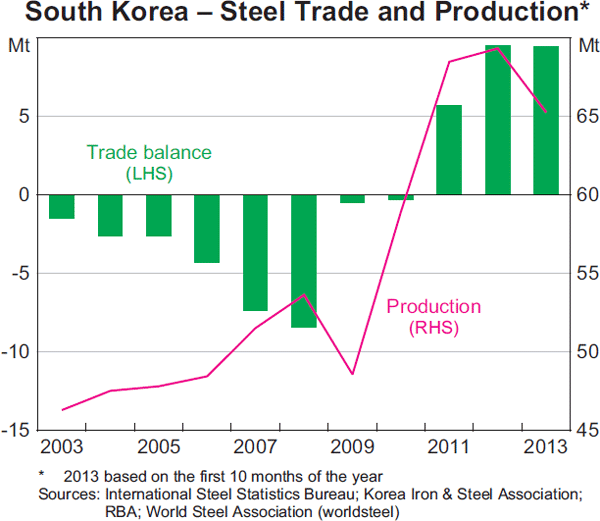
Domestic content of production
Korea's domestic content of manufacturing production increased from around 55 to 65 per cent between the mid 1990s and mid 2000s. Much of this rise stems from the increased use of Korean made steel. In contrast, in most east Asian economies the domestic content of production has decreased over time owing to growth in intra-industry regional trade and use of international supply chains (Graph 10; see also Berger-Thomson and Doyle (2013)).
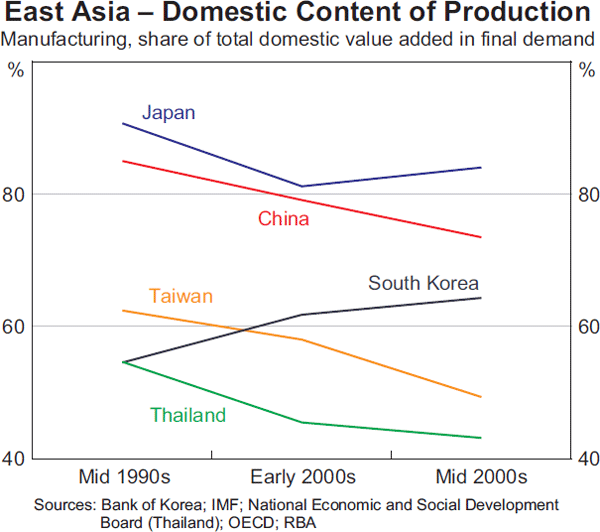
Despite the increase in the share of domestic content in production in Korea, Korean producers have also played a role in the integration of international supply chains. This role has mainly been as suppliers of intermediate goods, while Korean producers have also become increasingly important as suppliers of capital goods. Overall, Korea's share of the total value-added in manufacturing production in the east Asian region increased from 7 per cent of the total in the mid 1990s to 11 per cent in the mid 2000s.
Australian Exports to Korea
Korea is a major importer of Australian resource commodities owing to the resource intensity of its production. Indeed, Korea is Australia's third largest export destination. In 2012/13, 7 per cent of Australia's total exports (by value) were sent to Korea.
Over the past decade, resource exports have accounted for around 80 per cent of exports to Korea with rural, services and manufacturing exports accounting for the remainder (Graph 11).[3] The share of Australia's exports to Korea that is comprised of Australia's two most important resource exports, metal ores and coal, has increased over the past years. In 2012/13, metal ores and coal accounted for 33 and 24 per cent of total exports, respectively. The vast majority of services exports to Korea are Korean tourists visiting Australia, and meat and cereals are the primary rural exports.
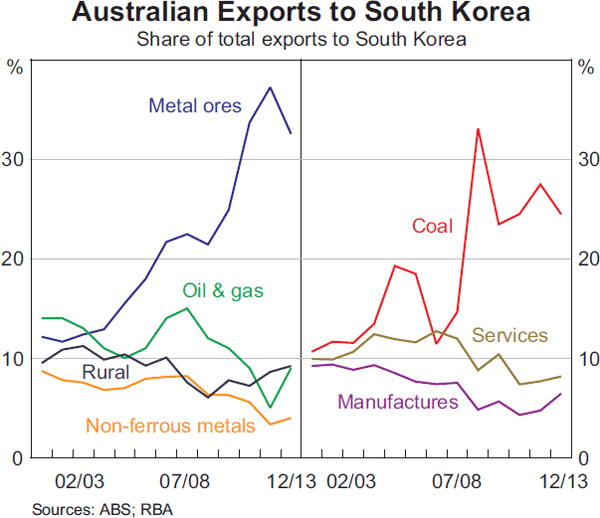
The surge in China's demand for resources has driven substantial price increases for a wide range of commodities, particularly for iron ore. However, the recent rise in the values of metal ores and coal exports to Korea is not entirely due to the rise in the price of these commodities, but also reflects rapid growth in the volume of these exports (Graph 12). Nevertheless, the rapid rise in exports to China over the past decade has seen the share of Australian iron ore exports that are destined for Korea decline from 15 per cent in 2001 to around 10 per cent in 2012.
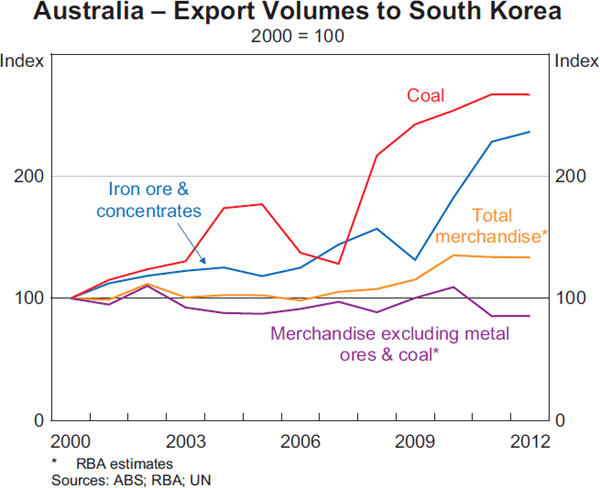
From Korea's perspective, Australia has become an increasingly important source of resource imports. The share of Korean iron ore imports coming from Australia has increased from just over 50 per cent in 2000 to around 70 per cent in 2012 (Graph 13). This increase reflects a global shift towards Australian iron ore and Korea's recent investment in blast furnace steel production.
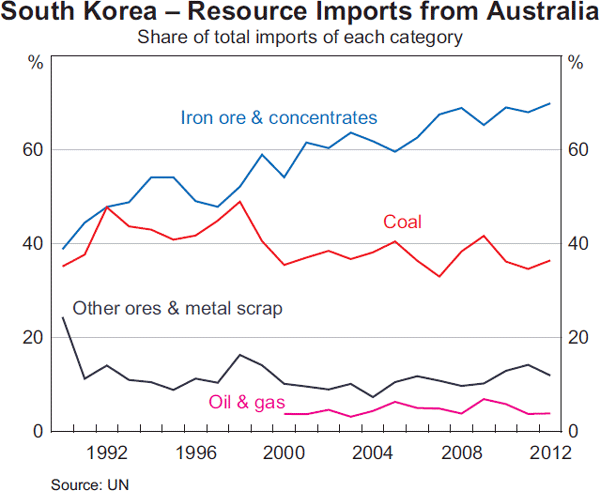
Much of Australia's exports to Korea are inputs to their steel-intensive manufacturing industries, which export a large share of their output. This means that demand for Korean exports in other countries has an effect on Korean demand for Australian exports. For example, around two-thirds of automobiles produced in Korea are exported, so demand for inputs to automobile production, including from Australia, depends to a large extent on final demand in those countries to which Korea exports automobiles.
Looking at the total Korean manufacturing sector, Kelly and La Cava (2013) note that only around 60 per cent of Australian exports to Korea are realised as final demand in Korea, which is a smaller share than any of Australia's other major trading partners (Graph 14). The remainder of Australian exports to Korea end up as final demand in other countries, including North American and European countries.
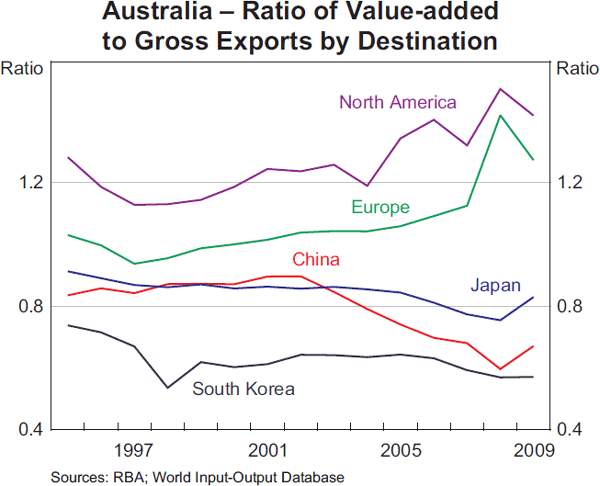
Conclusions
The Korean economy has grown rapidly over the past half century, with a notable expansion of export-oriented manufacturing, including steel-intensive industries, such as transport equipment and metal products. The reliance of these industries on raw material imports has made Korea an important destination for Australian exports.
Footnotes
The authors are from Economic Analysis Department. [*]
Korea's economic expansion has been marked by a few slowdowns. The economy contracted in 1980 amid the global downturn. There was a more substantial contraction in 1997–98 during the Asian financial crisis (see, for example, Grenville (1998)). In response to that crisis, the Korean Government adopted a flexible exchange rate, moved to inflation targeting and pursued a range of reforms to improve corporate governance and financial resilience (Lee 2008). During the global financial crisis, the Korean economy experienced a relatively mild slowdown. [1]
‘Chaebol’ refers to Korean large private business conglomerates, often family controlled and with strong ties to the government, such as Samsung, Hyundai and LG (Savada and Shaw 1990). [2]
The Australian and Korean Governments recently concluded their free trade agreement negotiations. The agreement is set to reduce tariffs on a range of rural and manufactured goods, as well reducing barriers to services trade. [3]
References
Amsden A (2004), ‘Import Substitution in High-tech Industries: Prebisch Lives in Asia!’, Cepal Review, 82, pp 475–489.
Berger-Thomson L and M-A Doyle (2013), ‘Shifts in Production in East Asia’, RBA Bulletin, June, pp 29–37.
BRS (Barry Rogliano Salles) (2013), ‘The Shipbuilding Market: At a Low Ebb’, in BRS 2013 Annual Review: Shipping and Shipbuilding Markets.
Craig A, S Elias and C Noone (2011), ‘Destinations and Uses of East Asian Merchandise Exports’, RBA Bulletin, June, pp 9–14.
European Commission (2009), ‘Study on Competitiveness of the European Shipbuilding Industry’, ENTR/06/054.
Greenbaum A (2002), ‘The Globalization of the Korean Automotive Industry’, Economic Strategy Institute, Washington DC.
Grenville S (1998), ‘The Asian Economic Crisis’, Address to the Australian Business Economists and the Economic Society of Australia (NSW Branch), Sydney, 12 March.
Haugh D, A Mourougane and O Chatal (2010), ‘The Automobile Industry in and Beyond the Crisis’, OECD Economics Department Working Papers No 745.
Hyundai Steel (2012), Annual Report 2012.
KAMA (Korea Automobile Manufacturers Association) (2012), Korean Automobile Industry Annual Report 2012.
Kelly G and G La Cava (2013), ‘Value-added Trade and the Australian Economy’, RBA Bulletin, March, pp 29–37.
KOSA (Korea Iron and Steel Association) (2013), ‘Korean Steel Industry’, 74th session of the OECD Steel Committee, 1–2 July.
Krueger A and J Yoo (2002), ‘Chaebol Capitalism and the Currency-Financial Crisis in Korea’, in S Edwards and J Frankel (eds), Preventing Currency Crises in Emerging Markets, University of Chicago Press, Chicago, pp 601–649.
Lee S (2008), ‘The Politics of Chaebol Reform in Korea: Social Cleavage and New Financial Rules’, Journal of Contemporary Asia, 38, pp 439–452.
Savada A and W Shaw (1990), ‘South Korea: A Country Study’, United States Library of Congress, Washington DC.
Worldsteel Association (2013a), ‘Statistics Archive’.
Available at
<http://www.worldsteel.org/statistics/statistics-archive.html>.
Worldsteel Association (2013b), ‘World Steel in Figures 2013’.
Available at <http://www.worldsteel.org/dms/internetDocumentList/bookshop/Word-Steel-in-Figures-2013/document/World%20Steel%20in%20Figures%202013.pdf>